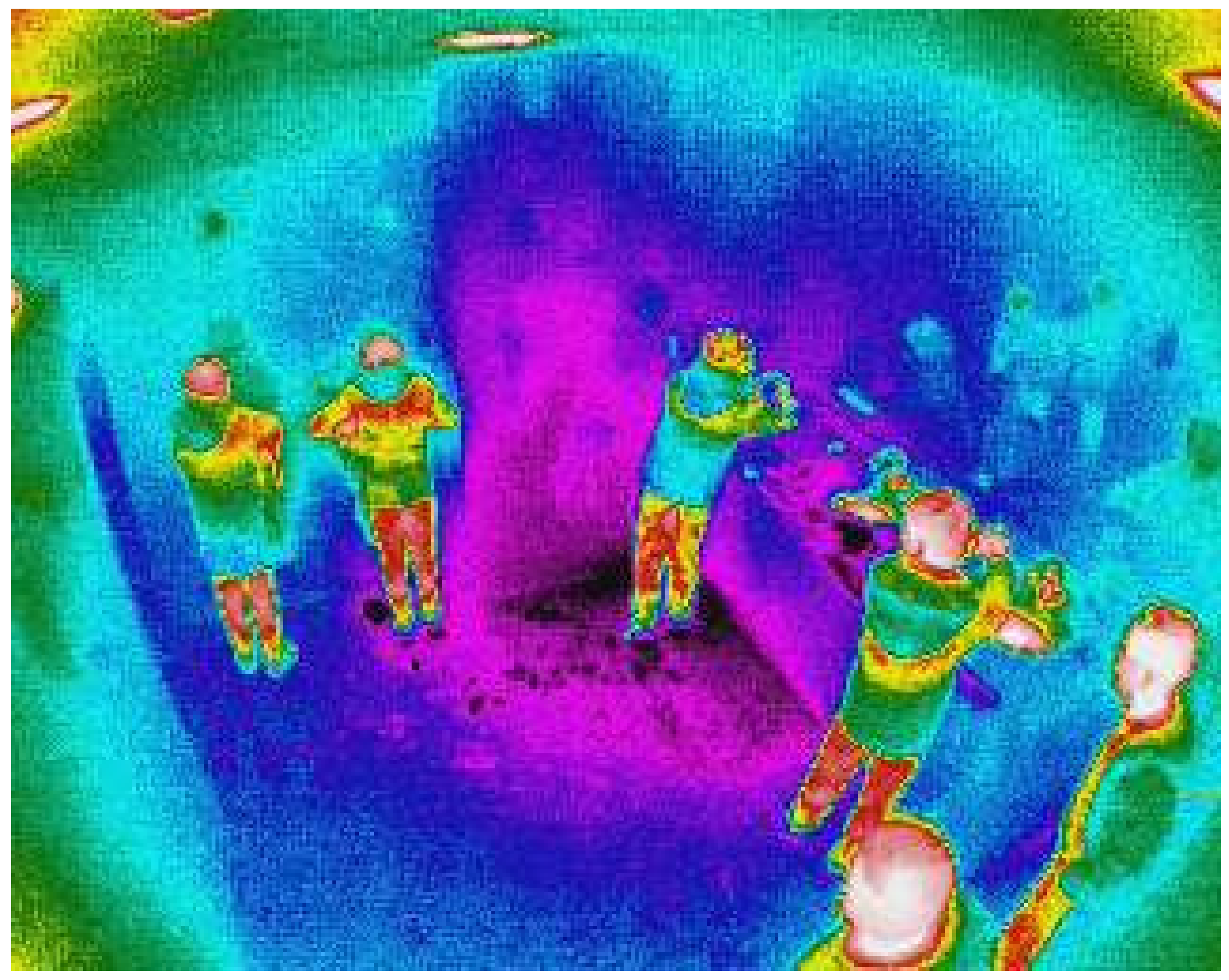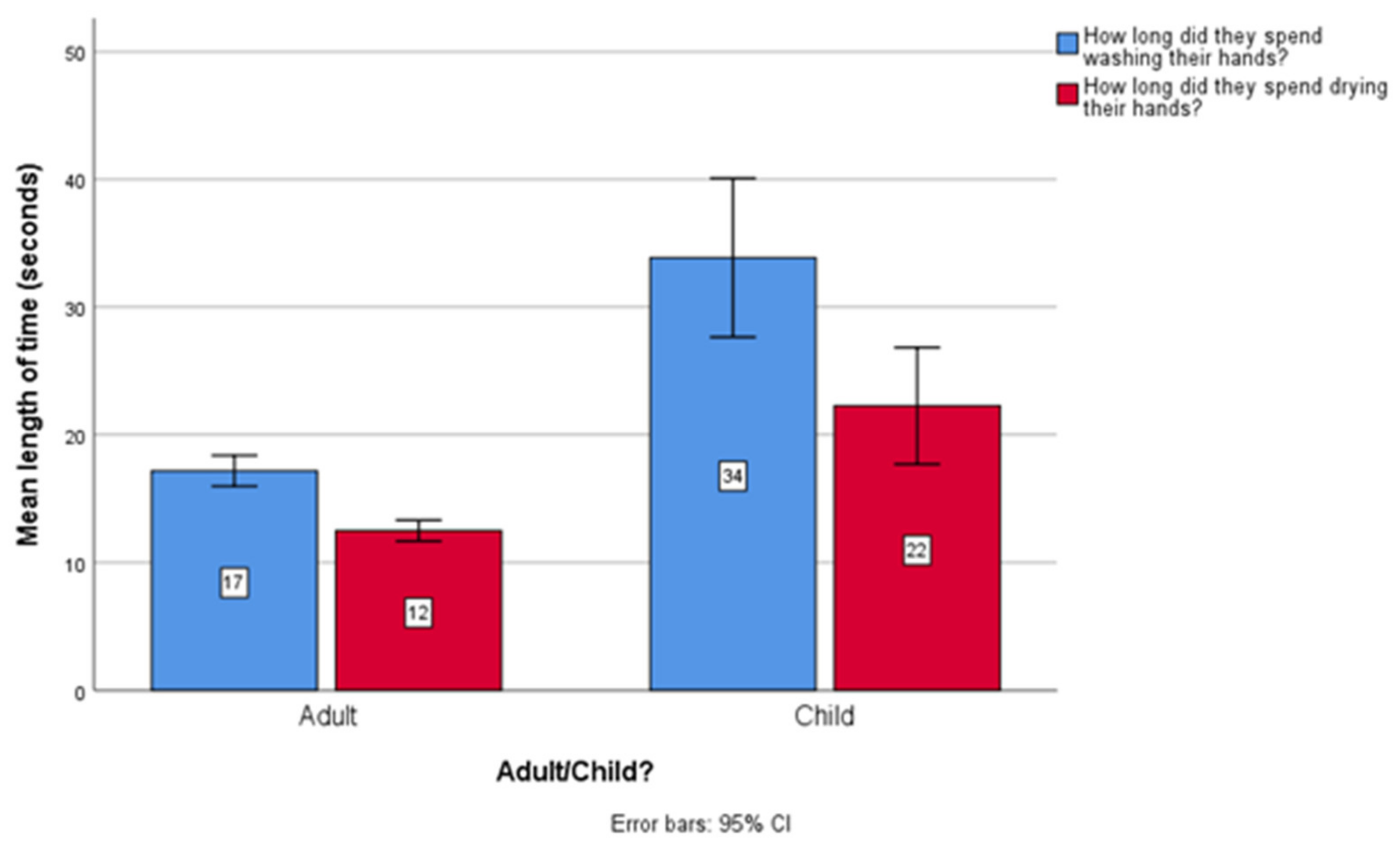An Evaluation of the Hand Hygiene Behaviour and Compliance of the General Public When Using Public Restrooms in Northern Ireland (NI) during the Initial Weeks of the Novel Coronavirus (COVID-19) Pandemic
Abstract
1. Introduction
2. Materials and Methods
2.1. Patient and Public Involvement
- Hand hygiene intention (did the person go to wash their hands?)
- Hand hygiene compliance (how did they wash their hands? Did they wash using only water or water and soap?)
- Time spent washing hands (was it </>20 s?)
- Hand drying intention (did the person go to dry their hands after washing?)
- Hand drying compliance (which method of drying did they use to dry their hands?)
- Time spent drying hands (was it </>15 s? This figure was based upon Dyson guidelines for their hand dryers).
- Gender (male or female)?
- Adult or child?
- Adequate hand hygiene: this involved washing hands with water, soap and then lathering for twenty seconds or more and scrubbing in various rotations and interlocking of fingers, after which hands are rinsed with water to remove soap excess and then dried properly using an appropriate drying method (only a Dyson hand dryer was available in this study) for fifteen seconds or more also [36].
- Basic hand hygiene: this involved washing hands with water, soap and scrubbing hands in various rotations and interlocking of fingers after which hands are rinsed with water to remove soap excess, and then dried afterward using an appropriate drying method (Dyson hand dryer) but not for the recommended minimum length of time [36].
- Poor hand hygiene: this involved any other combination of steps not fitting the two previous categories [36].
- Non-hand hygiene: this involved not washing or drying hands at all.
2.2. Data Analysis
3. Results
4. Discussion
5. Conclusions
Author Contributions
Funding
Institutional Review Board Statement
Informed Consent Statement
Data Availability Statement
Acknowledgments
Conflicts of Interest
References
- Heymann, D.L.; Shindo, N. COVID-19: What is next for public health? Lancet 2020, 395, 542–545. [Google Scholar] [CrossRef]
- Novel Coronavirus Pneumonia Emergency Response Epidemiology Team. Vital surveillances: The Epidemiological Characteristics of an Outbreak of 2019 Novel Coronavirus Diseases (COVID-19)—China. China CDC Weekly, 2020. Available online: http://weekly.chinacdc.cn/en/article/id/e53946e2-c6c4-41e9-9a9b-fea8db1a8f51 (accessed on 24 March 2020).
- John Hopkins University. COVID-19 Dashboard by the Center for Systems Science and Engineering (CSSE) at Johns Hopkins University [Internet]. Available online: https://coronavirus.jhu.edu/map.html (accessed on 24 April 2021).
- European Centre for Disease Prevention and Control. Available online: https://www.ecdc.europa.eu/en/geographical-distribution-2019-ncov-cases (accessed on 24 June 2020).
- Curtis, V.; Cairncross, S. Effect of washing hands with soap on diarrhoea risk in the community: A systematic review. Lancet Infect. Dis. 2003, 3, 275–281. [Google Scholar] [CrossRef]
- Chen, S.; Yang, J.; Yang, W.; Wang, C.; Bärnighausen, T. COVID-19 control in China during mass population movements at New Year. Lancet 2020, 395, 764–766. [Google Scholar] [CrossRef]
- Center for Disease Control (CDC) Coronavirus Disease 2019 (COVID-19)—How to Protect Yourself. Available online: https://www.cdc.gov/coronavirus/2019-ncov/prepare/prevention.html (accessed on 24 March 2020).
- World Health Organization (WHO). WHO Guidelines on Hand Hygiene in Health Care. 2009. Available online: https://www.who.int/gpsc/5may/tools/9789241597906/en/ (accessed on 24 March 2020).
- Oughton, M.T.; Loo, V.G.; Dendukuri, N.; Fenn, S.; Libman, M.D. Hand hygiene with soap and water is superior to al-cohol rub and antiseptic wipes for removal of Clostridium difficile. Infect. Control Hosp. Epidemiol. 2009, 30, 939–944. [Google Scholar] [CrossRef] [PubMed]
- Alharbi, S.A.; Salmen, S.H.; Chinnathambi, A.; Alharbi, N.S.; Zayed, M.; Al-Johny, B.O.; Wainwright, M. Assessment of the bacterial contamination of hand air dryer in washrooms. Saudi J. Biol. Sci. 2016, 23, 268–271. [Google Scholar] [CrossRef] [PubMed]
- Chou, D.T.; Achan, P.; Ramachandran, M. The World Health Organization ‘5 moments of hand hygiene’: The scientific foundation. J. Bone Jt. Surg. Br. 2012, 94, 441–445. [Google Scholar] [CrossRef] [PubMed]
- Center for Disease Control and Prevention (CDC). When and How to Wash Your Hands. 2015. Available online: http://www.cdc.gov/hand%20hygiene/when-how-hand hygiene.html (accessed on 24 March 2020).
- Mick, J.A. An alternative to singing “Happy Birthday”: Healthcare provider’s rhyme for hand hygiene time. Am. J. Infect. Control 2016, 44, 1759–1760. [Google Scholar] [CrossRef][Green Version]
- Anderson, M.E.C.; Sargeant, J.M.; Weese, J.S. Video observation of hand hygiene practices during routine companion animal appointments and the effect of a poster intervention on hand hygiene compliance. BMC Vet. Res. 2014, 10, 106. [Google Scholar] [CrossRef]
- Freeman, M.C.; Stocks, M.E.; Cumming, O.; Jeandron, A.; Higgins, J.P.T.; Wolf, J.; Pruss-Ustun, A.; Bonjour, S.; Hunter, P.R.; Fewtrell, L.; et al. Systematic review: Hygiene and health: Systematic review of hand hygiene practices worldwide and update of health effects. Trop. Med. Int. Health 2014, 19, 906–916. [Google Scholar]
- Van Beeck, A.H.E.; Zomer, T.P.; Van Beeck, E.F.; Richardus, J.H.; Voeten, H.A.C.M.; Erasmus, V. Children’s hand hygiene behaviour and available facilities: An observational study in Dutch day care centres. Eur. J. Public Health 2015, 26, 297–300. [Google Scholar] [CrossRef]
- Contzen, N.; De Pasquale, S.; Mosler, H.-J. Over-Reporting in Handwashing Self-Reports: Potential Explanatory Factors and Alternative Measurements. PLoS ONE 2015, 10, e0136445. [Google Scholar] [CrossRef] [PubMed]
- Oliveira, A.C.; de Paula, A.O.; Gama, C.S. Monitoring hand hygiene: Direct observation versus self-report rates. Enfermería Glob. 2017, 16, 344–353. [Google Scholar]
- Lary, D.; Calvert, A.; Nerlich, B.; Segal, J.; Vaughan, N.; Randle, J.; Hardie, K.R. Improving children’s and their visitors’ hand hygiene compliance. J. Infect. Prev. 2020, 21, 60–67. [Google Scholar] [CrossRef] [PubMed]
- Mariwah, S.; Hampshire, K.; Kasim, A.S. The impact of gender and physical environment on the handwashing behaviour of university students in Ghana. Trop. Med. Int. Health 2012, 17, 447–454. [Google Scholar] [CrossRef] [PubMed]
- Suen, L.K.P.; So, Z.Y.Y.; Yeung, S.K.W.; Lo, K.Y.K.; Lam, S.C. Epidemiological investigation on hand hygiene knowledge and behaviour: A cross-sectional study on gender disparity. BMC Public Health 2019, 19, 1–14. [Google Scholar] [CrossRef] [PubMed]
- Curtis, V. Talking dirty: How to save a million lives. Int. J. Environ. Health Res. 2003, 13, S73–S79. [Google Scholar] [CrossRef] [PubMed]
- Curtis, V.A.; Danquah, L.O.; Aunger, R.V. Planned, motivated and habitual hygiene behaviour: An eleven country review. Health Educ. Res. 2009, 24, 655–673. [Google Scholar] [CrossRef]
- Jones, J.H.; Salathé, M. Early Assessment of Anxiety and Behavioral Response to Novel Swine-Origin Influenza A(H1N1). PLoS ONE 2009, 4, e8032. [Google Scholar] [CrossRef]
- Goldmann, D. System Failure versus Personal Accountability—The Case for Clean Hands. N. Engl. J. Med. 2006, 355, 121–123. [Google Scholar] [CrossRef] [PubMed]
- Meilicke, G.; Riedmann, K.; Biederbick, W.; Müller, U.; Wierer, T.; Bartels, C. Hygiene perception changes during the influenza A H1N1 pandemic in Germany: Incorporating the results of two cross-sectional telephone surveys 2008–2009. BMC Public Health 2013, 13, 959. [Google Scholar] [CrossRef]
- Park, J.-H.; Cheong, H.-K.; Son, D.-Y.; Kim, S.-U.; Hae-Kwan, C. Perceptions and behaviors related to hand hygiene for the prevention of H1N1 influenza transmission among Korean university students during the peak pandemic period. BMC Infect. Dis. 2010, 10, 222. [Google Scholar] [CrossRef] [PubMed]
- Kwok, K.O.; Li, K.K.; Chan, H.H.; Yi, Y.Y.; Tang, A.; Wei, W.I.; Wong, Y.S. Community responses during the early phase of the COVID-19 epidemic in Hong Kong: Risk perception, information exposure and preventive measures. medRxiv 2020. [Google Scholar] [CrossRef]
- Martins, S.; Osiyemi, A. Hand hygiene practices post ebola virus disease outbreak in a nigerian teaching hospital. Ann. Ib. Postgrad. Med. 2017, 15, 16–22. [Google Scholar] [PubMed]
- Lau, J.T.F.; Yang, X.; Tsui, H.; Kim, J.H. Monitoring community responses to the SARS epidemic in Hong Kong: From day 10 to day 62. J. Epidemiol. Community Health 2003, 57, 864–870. [Google Scholar] [CrossRef] [PubMed]
- Pogrebna, G.; Kharlamov, A. The impact of cross-cultural differences in handwashing patterns on the COVID-19 out-break magnitude. Regul. Gov. 2020, 10. advance online publication. [Google Scholar]
- Haque, M. Handwashing in averting infectious diseases: Relevance to COVID-19. J. Popul. Ther. Clin. Pharmacol. 2020, 27, e37–e52. [Google Scholar] [CrossRef]
- Sayeed, A.; Rahman, H.; Bundschuh, J.; Herath, I.; Ahmed, F.; Bhattacharya, P.; Tariq, M.R.; Rahman, F.; Joy, T.I.; Abid, M.T.; et al. Handwashing with soap: A concern for overuse of water amidst the COVID-19 pandemic in Bangladesh. Groundw. Sustain. Dev. 2021, 13, 100561. [Google Scholar] [CrossRef]
- Srigley, J.A.; Furness, C.D.; Baker, G.R.; Gardam, M. Quantification of the Hawthorne effect in hand hygiene compliance monitor-ing using an electronic monitoring system: A retrospective cohort study. BMJ Qual. Saf. 2014, 23, 974–980. [Google Scholar] [CrossRef]
- Belfast City Council. Belfast Resilience Assessment—City Facts: Belfast. 2020. Available online: https://www.belfastcity.gov.uk/Documents/Resilience-Assessment (accessed on 6 June 2021).
- Lawson, A.; Vaganay-Miller, M. The Effectiveness of a Poster Intervention on Hand Hygiene Practice and Compliance When Using Public Restrooms in a University Setting. Int. J. Environ. Res. Public Health 2019, 16, 5036. [Google Scholar] [CrossRef] [PubMed]
- A Charitos, I.; Ballini, A.; Bottalico, L.; Cantore, S.; Passarelli, P.C.; Inchingolo, F.; D’Addona, A.; Santacroce, L. Special features of SARS-CoV-2 in daily practice. World J. Clin. Cases 2020, 8, 3920–3933. [Google Scholar] [CrossRef] [PubMed]
- Inchingolo, A.; Inchingolo, A.; Bordea, I.; Malcangi, G.; Xhajanka, E.; Scarano, A.; Lorusso, F.; Farronato, M.; Tartaglia, G.; Isacco, C.; et al. SARS-CoV-2 Disease Adjuvant Therapies and Supplements Breakthrough for the Infection Prevention. Microorganisms 2021, 9, 525. [Google Scholar] [CrossRef] [PubMed]


| Hand Hygiene (HH) Compliance Category | Total Hand Hygiene Compliance Rate during Observation Period % (n) | ||||
|---|---|---|---|---|---|
| Total | Male | Female | Adult | Child | |
| Adequate HH | 17.07 (85) | 19.69 (50) | 14.34 (35) | 14.35 (65) | 44.44 (20) |
| Basic HH | 62.65 (312) | 57.48 (146) | 68.03 (166) | 64.02 (290) | 48.89 (22) |
| Poor HH | 13.05 (65) | 12.99 (33) | 13.11 (32) | 13.69 (62) | 6.67 (3) |
| Non-HH | 7.23 (36) | 9.84 (25) | 4.51 (21) | 7.95 (36) | 0.00 (0) |
| Total | 100.00 (498) | 100.00 (254) | 100.00 (244) | 100.00 (453) | 100.00 (45) |
Publisher’s Note: MDPI stays neutral with regard to jurisdictional claims in published maps and institutional affiliations. |
© 2021 by the authors. Licensee MDPI, Basel, Switzerland. This article is an open access article distributed under the terms and conditions of the Creative Commons Attribution (CC BY) license (https://creativecommons.org/licenses/by/4.0/).
Share and Cite
Lawson, A.; Cameron, R.; Vaganay-Miller, M. An Evaluation of the Hand Hygiene Behaviour and Compliance of the General Public When Using Public Restrooms in Northern Ireland (NI) during the Initial Weeks of the Novel Coronavirus (COVID-19) Pandemic. Int. J. Environ. Res. Public Health 2021, 18, 6385. https://doi.org/10.3390/ijerph18126385
Lawson A, Cameron R, Vaganay-Miller M. An Evaluation of the Hand Hygiene Behaviour and Compliance of the General Public When Using Public Restrooms in Northern Ireland (NI) during the Initial Weeks of the Novel Coronavirus (COVID-19) Pandemic. International Journal of Environmental Research and Public Health. 2021; 18(12):6385. https://doi.org/10.3390/ijerph18126385
Chicago/Turabian StyleLawson, Aaron, Robert Cameron, and Marie Vaganay-Miller. 2021. "An Evaluation of the Hand Hygiene Behaviour and Compliance of the General Public When Using Public Restrooms in Northern Ireland (NI) during the Initial Weeks of the Novel Coronavirus (COVID-19) Pandemic" International Journal of Environmental Research and Public Health 18, no. 12: 6385. https://doi.org/10.3390/ijerph18126385
APA StyleLawson, A., Cameron, R., & Vaganay-Miller, M. (2021). An Evaluation of the Hand Hygiene Behaviour and Compliance of the General Public When Using Public Restrooms in Northern Ireland (NI) during the Initial Weeks of the Novel Coronavirus (COVID-19) Pandemic. International Journal of Environmental Research and Public Health, 18(12), 6385. https://doi.org/10.3390/ijerph18126385






